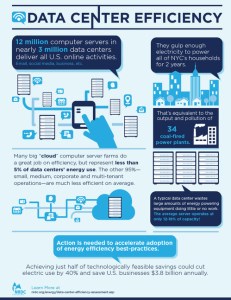by Brianna Crandall — September 10, 2014—Much of the massive amounts of electricity that America’s data centers devour to support the nation’s business and online activity is being wasted running computer servers doing little or no work most of the time, according to a new report from the international nonprofit Natural Resources Defense Council (NRDC). Improved energy efficiency practices could reportedly cut energy waste by at least 40%, saving over $3 billion annually.
“Most of the attention is focused on the highly visible hyperscale ‘cloud’ data centers like Google’s and Facebook’s, but they already are very efficient and represent less than 5% of U.S. data center electricity consumption. Our small, medium, corporate, and multi-tenant data centers are still squandering huge amounts of energy,” said Pierre Delforge, NRDC director of high-tech energy efficiency.
 The NRDC infographic promotes taking action to reduce data center inefficiency.
The NRDC infographic promotes taking action to reduce data center inefficiency.(Click on image to enlarge)
Developed in partnership with Anthesis, “Scaling Up Energy Efficiency Across the Data Center Industry: Evaluating Key Drivers and Barriers” notes that while huge “cloud” server farms have made significant efficiency improvements, progress has been much slower and uneven across the nearly 3 million other data centers in businesses and organizations that house 95% of servers across the country, costing them billions of dollars and kilowatt-hours. In fact, up to one-third of servers are no longer needed but are still consuming large amounts of electricity, while many others are grossly underutilized, operating at no more than 18% of capacity, the report said.
On the whole, U.S. data centers guzzled an estimated 91 billion kilowatt-hours of electricity in 2013—enough to power all of New York City’s households twice over and growing. And U.S. data center power needs are expected to grow significantly; by 2020, annual data center energy consumption is expected to reach 140 billion kilowatt-hours. This could cost business $13 billion annually for electricity equivalent to that generated by 50 large coal-fired power plants emitting nearly 150 million tons of carbon pollution.
Although the full extent of energy waste is unknown due to a lack of consistent metrics, the report estimates that if just half of the potential savings from cost-effective energy efficiency best practices were realized, electricity use could be cut by 40%. In 2014, that would equal $3.8 billion in savings for businesses and cut 39 billion kilowatt-hours of electricity.
“New practices and policies are needed to accelerate the pace and scale of the adoption of energy efficiency best practices throughout the industry,” Delforge said. “Nearly one-third of all leased data center space will come up for renewal over the next year, so the time to act is now.”
Key findings from the NRDC-Anthesis report include:
- Up to 30% of servers are “comatose” and no longer needed because projects have ended or business processes changed, but are still plugged in and consuming electricity.
- Much of the energy consumed by U.S. data centers powers servers operating at 12%-18% of capacity. Even sitting virtually idle, servers use significant amounts of power 24/7.
- In 80% of organizations, the department responsible for data center management is separate from the one paying the electric bills. This “split incentive” reduces the likelihood of implementation of commonsense efficiency measures.
The report makes a number of recommendations, including: aligning incentives for decision makers, developing simple metrics for measuring server utilization, public disclosure of data center energy and carbon performance, and establishing “green leases” for multi-tenant data centers.
Short and long versions of the report can be found on the NRDC site, as can Delforge’s blog and the infographic on this page.





